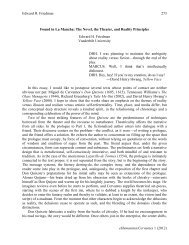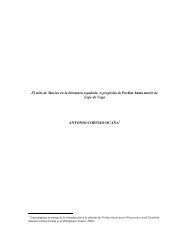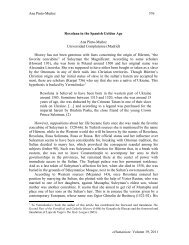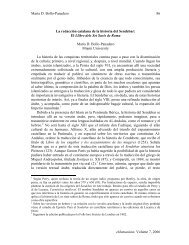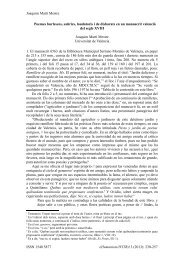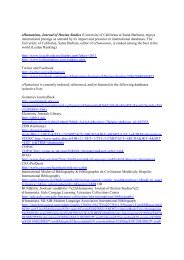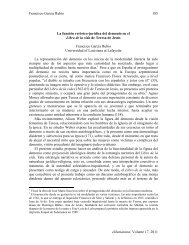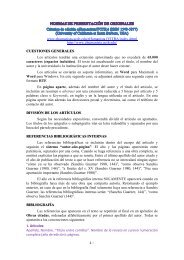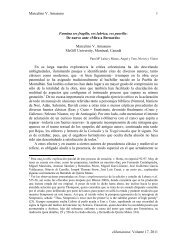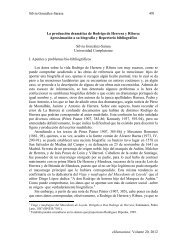Gregory Peter Andrachuk eHumanista: Volume 17, 2011 540 Alonso ...
Gregory Peter Andrachuk eHumanista: Volume 17, 2011 540 Alonso ...
Gregory Peter Andrachuk eHumanista: Volume 17, 2011 540 Alonso ...
Create successful ePaper yourself
Turn your PDF publications into a flip-book with our unique Google optimized e-Paper software.
<strong>Gregory</strong> <strong>Peter</strong> <strong>Andrachuk</strong><br />
courtly accomplishments the art of writing poetry, but he was also known as a skilled<br />
prose writer. While we have evidence of his poetry in the compositions of the<br />
Cancionero General, we have no declared examples of his prose writing unless we<br />
accept as his the prosimetrum work Qüestión de amor.<br />
<strong>Alonso</strong> de Cardona, Almirante de Aragón<br />
There are numerous historical references to <strong>Alonso</strong> de Cardona, Almirante de<br />
Aragón, during the period of Charles I. It is this military and administrative rank<br />
which we can use as a guide in identifying his genealogy and which will also help in<br />
furthering our search for the author of Qüestión de amor. We have already seen the<br />
instance of the siege of Perpignan (1503) in which <strong>Alonso</strong> de Cardona, eventual<br />
Almirante, is mentioned as being in the company of the same nobles as <strong>Alonso</strong> de<br />
Cardona, poet. There are further sources which confirm these associations. A private<br />
diary now known as the Diario turolense was written by Juan Gaspar Sánchez Muñoz<br />
over a span of decades in the 16 th century and published in 1895 in the Boletín de la<br />
Real Academia de Historia. In this work we find not only the expected recording of<br />
family matters, household maintenance, and private reflections, but also observations<br />
on historical events which the author found noteworthy. The horrific casualties of the<br />
battle of Ravenna, for example, are recorded thus: “A xj de abril de 1512 la gente del<br />
papa y la gente del rey de España que favorecía al papa dieron una cruel batalla sobre<br />
la ciudat de Ravena contra los franceses, día de Pascua de la Resurrección...mataron<br />
de franceses 12,000 hombres, de manera que en la dicha batalla murieron sobre 20,000<br />
hombres” (20). The first specific mention of <strong>Alonso</strong> de Cardona in this text comes in<br />
the entry for July 1521 which speaks of the violent uprising of the agermanados, 28 and<br />
of a strategy meeting at which the royalist leaders are gathered: “Juntáronse más con<br />
el virrey y los más caballeros del reino de Valencia, adonde fueron...don <strong>Alonso</strong> de<br />
Cardona, Almirante de Aragón, y don Juan de Vorja, Duque de Gandía, y don Serafín<br />
de Centelles, Conde de Oliva” (40). <strong>Alonso</strong> de Cardona had been among the few<br />
nobles who in 1519 sided with the king in his early disputes with the Valencian<br />
aristocracy over the licensing of the germanías or guilds. In fact, the part played by<br />
<strong>Alonso</strong> de Cardona in support of the king was not an incidental one. By 1521 the<br />
major part of the nobility was siding with the king and it was <strong>Alonso</strong> de Cardona who<br />
hosted a meeting of the highest nobles to formulate their plans (this is perhaps the<br />
same meeting which Juan Gaspar Muñoz records). Pascual Madoz reports: “En 1521,<br />
celebró en (Gandía) una reunión el Almirante de Aragón D. <strong>Alonso</strong> de Cardona, a la<br />
que acudió el virrey de Valencia D. Diego Hurtado de Mendoza, y resolvieron<br />
convocar a todos los caballeros del reino y facultar al señor de Rocafull, para formar<br />
28 The revolt of the artisan guilds (germanías) in the region of Valencia lasted from 1519 to 1523 and<br />
broadly corresponded to the revolt of the comuneros in Castile, both uprisings reflecting dissatisfaction<br />
with the early reign of Charles I, although the specific causes were different. The most active year of<br />
rebellion in the area of Valencia was 1521.<br />
552<br />
<strong>eHumanista</strong>: <strong>Volume</strong> <strong>17</strong>, <strong>2011</strong>



